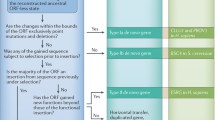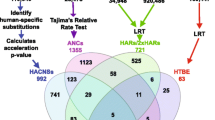Abstract
The moment of MR1 discovery is described. The MR1 gene is the first and the last reported human MHC-related gene intentionally isolated from the human genome composed of three billion base pairs. Evolutionary considerations formed the basis of its isolation. Some details surrounding the moment and some retrospective descriptions with various kinds of encounters are also included.




Similar content being viewed by others
References
Araki T, Fumitake G, Takagaki K, Haupt H, Schwick HG et al (1988) Complete amino acid sequence of human plasma Zn-α2-glycoprotein and its homology to histocompatibility antigens. Proc Natl Acad Sci U S A 85:679–683
Bahram S, Bresnahan M, Geraghty DE, Spies T (1994) A second lineage of mammalian major histocompatibility complex class I genes. Proc Natl Acad Sci U S A 91:6259–6263
Beckman EM, Porcelli SA, Morita CT, Behar SM, Furlong ST, Brenner MB (1994) Recognition of a lipid antigen by CD1-restricted αβ+ T cells. Nature 372:691–694
Bendelac A, Lantz O, Quimby ME, Yewdell JW, Bennink JR, Brutkiewicz RR (1995) CD1 recognition by mouse NK1+ T lymphocytes. Science 268:863–865
Borg NA, Wun KS, Kjer-Nielsen L, Wilce MCJ, Pellicci DG, Koh R, Bersa GS, Bharadwaj M, Godfrey DI, McCluskey J, Rossjohn J (2007) CD1d-lipid-antigen recognition by the semi-invariant NKT-cell receptor. Nature 448:44–49
Boudinot P, Mondot S, Jouneau L, Teyton L, Lefranc M-P, Lantz O (2016) Restricting nonclassical MHC genes coevolve with TRAV genes used by innate-like T cells in mammals. Proc Natl Acad Sci U S A 113:E2983–E2992
Bourhis LL, Martin E, Peguillet I, Guihot A, Froux N, Core M, Levy E, Dusseaux M, Meyssonnier V, Premel V, Ngo C, Riteau B, Duban L, Robert D, Rottman M, Soudais C, Lantz O (2010) Antimicrobial activity of mucosal-associated invariant T cells. Nat Immunol 11:701–708
Calabi F, Milstein C (1986) A novel family of human major histocompatibility complex-related genes not mapping to chromosome 6. Nature 323:540–543
Cosman D, Mullberg J, Sutherland CL, Chin W, Armitage R, Fanslow W, Kubin M, Chalupny NJ (2001) ULBPs, novel MHC class I-related molecules, bind to CMV glycoprotein UL16 and stimulate NK cytotoxicity through the NKG2D receptor. Immunity 14:123–133
Feder JN, Gnirke A, Thomas W, Tsuchihashi Z, Ruddy DA et al (1996) A novel MHC class I-like gene is mutated in patients with hereditary haemochromatosis. Nat Genetics 13:399–408
Fukudome K, Esmon CT (1994) Identification, cloning, and regulation of a novel endothelial cell protein C/activated protein C receptor. J Biol Chem 269:26486–26491
Garboczi DN, Ghosh P, Utz U, Fan QR, Biddison WE, Wiley DC (1996) Structure of the complex between human T-cell receptor, viral peptide and HLA-A2. Nature 384:134–141
Garcia KC, Degano M, Stanfield RL, Brunmark A, Jackson MR, Peterson PA, Teyton L, Wilson IA (1996) An αβ T cell receptor structure at 2.5 Å and its orientation in the TCR-MHC complex. Science 274:209–219
Girardi E, Maricic I, Wang J, Mac T-T, Iyer P, Kumar V, Zajonc DM (2012) Type II natural killer T cells use features of both innate and conventional T cells to recognize sulfatide self antigens. Nat Immunol 13:851–856
Gold MC, Cerri S, Smyk-Pearson S, Cansler ME, Vogt TM, Delepine J, Winata E, Swarbrick GM, Chua W-J, Yu YYL, Lantz O, Cook M, Null MD, Jacoby DB, Harriff MJ, Lewinsohn DA, Hansen TH, Lewinsohn DM (2010) Human mucosal associated invariant T cells detect bacterially infected cells. PLoS Biol 8:e1000407
Hashimoto K, Loader JE, Kinsky SC (1985) Synthesis and characterization of methotrexate-dimyristoylphosphatidylethanolamine derivatives and the glycerophosphorylethanolamine analogs. Biochim Biophys Acta 816:163–168
Hashimoto K, Nakanishi T, Kurosawa Y (1990) Isolation of carp genes encoding major histocompatibility complex antigens. Proc Natl Acad Sci U S A 87:6863–6867
Hashimoto K, Nakanishi T, Kurosawa Y (1992) Identification of a shark sequence resembling the major histocompatibility complex class I α3 domain. Proc Natl Acad Sci U S A 89:2209–2212
Hashimoto K, Hirai M, Kurosawa Y (1995) A gene outside the human MHC related to classical HLA class I genes. Science 269:693–695
Hashimoto K, Hirai M, Kurosawa Y (1997) Identification of a mouse homolog for the human hereditary haemochromatosis candidate gene. Biochem Biophys Res Commun 230:35–39
Hashimoto K, Okamura K, Yamaguchi H, Ototake M, Nakanishi T, Kurosawa Y (1999) Conservation and diversification of MHC class I and its related molecules in vertebrates. Immunol Rev 167:81–100
Huang S, Gilfillan S, Cella M, Miley MJ, Lantz O, Lybarger L, Fremont DH, Hansen TH (2005) Evidence for MR1 antigen presentation to mucosal-associated invariant T cells. J Biol Chem 280:21183–21193
Huang S, Martin E, Kim S, Yu L, Soudais C, Fremont DH, Lantz O, Hansen TH (2009) MR1 antigen presentation to mucosal-associated invariant T cells was highly conserved in evolution. Proc Natl Acad Sci U S A 106:8290–8295
Kjer-Nielsen L, Patel O, Corbett AJ, Le Nours J, Meehan B, Liu L, Bhati M, Chen Z, Kostenko L, Reantragoon R, Williamson NA, Purcell AW, Dudek NL, McConville MJ, O’Hair RAJ, Khairallah GN, Godfrey DI, Fairlie DP, Rossjohn J, McCluskey J (2012) MR1 presents microbial vitamin B metabolites to MAIT cells. Nature 491:717–723
Lander ES, Linton LM, Birren B, Nusbaum C, Zody MC et al (2001) Initial sequencing and analysis of the human genome. Nature 409(6822):860–921
Leelayuwat C, Townend DC, Degli-Epsosti MA, Abraham LJ, Dawkins RL (1994) A new polymorphic and multicopy MHC gene family related to nonmammalian class I. Immunogenetics 40(5):339–351
Lopez-Sagaseta J, Dulberger CL, Crooks JE, Parks CD, Luoma AM, McFedries A, Van Rhijn I, Saghatelian A, Adams EJ (2013a) The molecular basis for mucosal-associated invariant T cell recognition of MR1 proteins. Proc Natl Acad Sci U S A 110:E1771–E1778
Lopez-Sagaseta J, Dulberger CL, McFedries A, Cushman M, Saghatelian A, Adams EJ (2013b) MAIT recognition of a stimulatory bacterial antigen bound to MR1. J Immunol 191:5268–5277
Martin E, Treiner E, Duban L, Guerri L, Lauda H, Toly C, Premel V, Devys A, Moura IC, Tilloy F, Cherif S, Vera G, Latour S, Soudais C, Lantz O (2009) Stepwise development of MAIT cells in mouse and human. PLoS Biol 7, e54
Okamura K, Ototake M, Nakanishi T, Kurosawa Y, Hashimoto K (1997) The most primitive vertebrates with jaws possess highly polymorphic MHC class I genes comparable to those of humans. Immunity 7:777–790
Patel O, Pellicci DG, Gras S, Sandoval-Romero ML, Uldrich AP, Mallevaey T, Clarke AJ, Le Nours J, Theodossis A, Cardell SL, Gapin L, Godfrey DI, Rossjohn J (2012) Recognition of CD1d-sulfatide mediated by a type II natural killer T cell antigen receptor. Nat Immunol 13:857–863
Patel O, Kjer-Nielsen L, Le Nours J, Eckle SBG, Birkinshaw R, Beddoe T, Corbett AJ, Liu L, Miles JJ, Meehan B, Reantragoon R, Sandoval-Romero ML, Sullivan LC, Brooks AG, Chen Z, Fairlie DP, McCluskey J, Rossjohn J (2013) Recognition of vitamin B metabolites by mucosal-associated invariant T cells. Nat Commun 4:2142
Pettersen EF, Goddard TD, Huang CC, Couch GS, Greenblatt DM, Meng EC, Ferrin TE (2004) UCSF chimera—a visualization system for exploratory research and analysis. J Comput Chem 25:1605–1612
Porcelli S, Yockey CE, Brenner MB, Balk SP (1993) Analysis of T cell antigen receptor (TCR) expression by human peripheral blood CD4−8− α/β T cells demonstrates preferential use of several Vβ genes and an invariant TCR α chain. J Exp Med 178:1–16
Reantragoon R, Kjer-Nielsen L, Patel O, Chen Z, Illing PT, Bhati M, Kostenko L, Bharadwaj M, Meehan B, Hansen TH, Godfrey DI, Rossjohn J, McCluskey J (2012) Structural insight into MR1-mediated recognition of the mucosal associated invariant T cell receptor. J Exp Med 209:761–774
Riegert P, Wanner V, Bahram S (1998) Genomics, isoforms, expression, and phylogeny of the MHC class I-related MR1 gene. J Immunol 161:4066–4077
Rothbarth K, Petzelt C, Lu X, Todorov IT, Joswig G, Pepperkok R, Ansorge W, Werner D (1993) cDNA-derived molecular characteristics and antibodies to a new centrosome-associated and G2/M phase-prevalent protein. J Cell Sci 104:19–30
Simister NE, Mostov KE (1989) An Fc receptor structurally related to MHC class I antigens. Nature 337:184–187
Tilloy F, Treiner E, Park S-H, Garcia C, Lemonnier F, de la Salle H, Bendelac A, Bonneville M, Lantz O (1999) An invariant T cell receptor a chain defines a novel TAP-independent major histocompatibitily complex class Ib-restricted α/β T cell subpopulation in mammals. J Exp Med 189:1907–1921
Treiner E, Duban L, Bahram S, Radosavijevic M, Wanner V, Tilloy F, Affaticatl P, Gilfillan S, Lantz O (2003) Selection of evolutionarily conserved mucosal-associated invariant T cells by MR1. Nature 422:164–169
Tsukamoto K, Deakin JE, Graves JAM, Hashimoto K (2013) Exceptionally high conservation of the MHC class I-related gene, MR1, among mammals. Immunogenetics 65:115–124
Venter JC, Adams MD, Myers EW, Li PW, Mural RJ et al (2001) The sequence of the human genome. Science 291(5507):1304–1351
Yamaguchi H, Hirai M, Kurosawa Y, Hashimoto K (1997) A highly conserved major histocompatibility complex class I-related gene in mammals. Biochem Biophys Res Commun 238:697–702
Young MH, U’Ren L, Huang S, Mallevaey T, Scott-Browne J, Crawford F, Lantz O, Hansen TH, Kappler J, Marrack P, Gapin L (2013) MAIT cell recognition of MR1 on bacterially infected and uninfected cells. PLoS One 8, e53789
Zeng Z-H, Castano AR, Segelke BW, Stura EA, Peterson PA, Wilson IA (1997) Crystal structure of mouse CD1: an MHC-like fold with a large hydrophobic binding groove. Science 277:339–345
Zou Z, Nomura M, Takihara Y, Yasunaga T, Shimada K (1996) Isolation and characterization of retinoic acid-inducible cDNA clones in F9 cells: a novel cDNA family encodes cell surface proteins sharing partial homology with MHC class I molecules. J Biochem 119:319–328
Author information
Authors and Affiliations
Corresponding author
Additional information
This article is published in the Special Issue CD1, MR1, NKT, and MAIT: Evolution and Origins of Non-peptidic Antigen Recognition by T lymphocytes with Guest Editor Dr. Dirk Zajonc.




